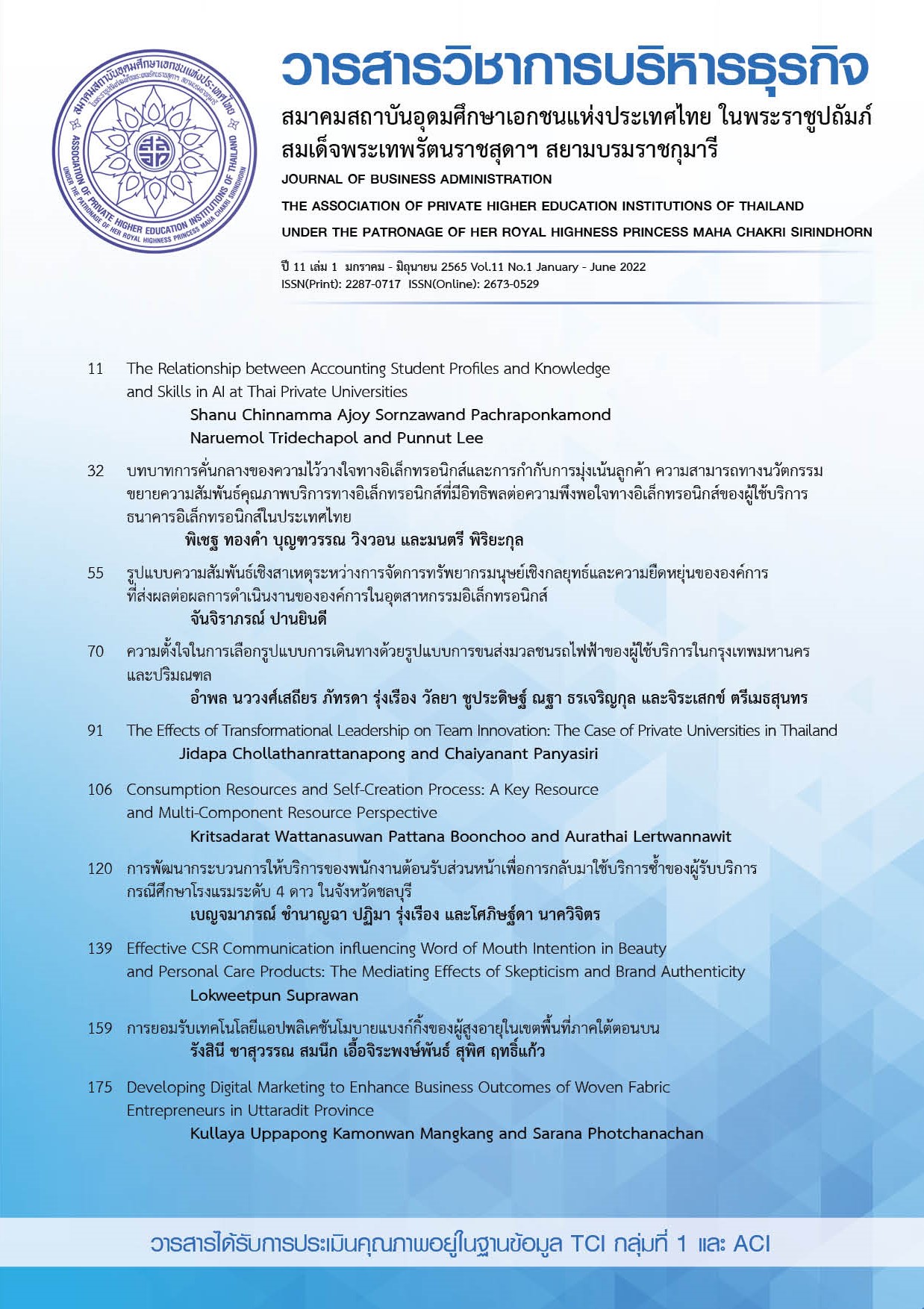Factors Affecting The Intention of Mode Choice Transportation by The Mass Rapid Transit of Passengers in Bangkok and Its Vicinities
Keywords:
Intention, Mode choice transportation, Mass rapid transitAbstract
The research aimed to analyze the factors affecting the intention of mode choice transportation by the mass rapid transit of passengers in Bangkok and its vicinities. The primary data collected from online questionnaires sent to the sample group, obtained from non-probability sampling and specified sampling method from residents of Bangkok or its vicinities who use all forms of mass transit services using a structural equation model. The study found that the cost of travel, reliability and convenience Influence the choice of mass rapid transit mode. The factors influencing the choice of mass rapid transit mode influenced the intention of choosing the mass rapid transit mode; the model was harmoniously consistent with the empirical data with a statistical value of c2 =912.831 df.= 492, c2/df. = 1.855 p-value =.050,CMIN/DF = 1.855, GFI = .991, TLI = .992, AGFI= .990 และ CFI = .984, RMSEA = .038 at a significance level of .05. The study results will be used to make policy decisions that solve the country's problems and meet the needs of the people who use the mass rapid transit. And it is consistent with public and private investment policies for the maximum benefit of providing services to the people of Bangkok and its vicinities. At the same time, the research findings can be generalized theoretically by linking to the context of education for the benefit of the next academic communities.
References
Adjadjhoue, C. R. (1995). Corridor analysis and forecasting of intermodal transportation systems between Finland and Eastern European countries, Acta Polytechnnica Scandinavia. Civil Engineering and Building Construction Series. No. 101. Finnish Academy of Technology, Helsinki.
Ajzen, I., & Fishbein, M. (1980). Understanding attitudes and prediction social behavior. New Jerzy: Prentice-Hall.
Ajzen, I. (1985). From intention to actions: A theory of planned behavior. In J, Kuhl., & J, Beckmann. Action control: From cognition to behavior. (pp. 11-39). Springer, Berlin, Heidelberg.
Bovy PHL. & Hoogendoorn, L. S. (2005). Modelling route choice behaviour in multi- modal transport networks. Transportation, 32(4), 341–368.
Burnkrant, R. E., & Cousineau, A. (1975). Informational and normative social influence in buyer behavior. Journal of Consumer Research. 2(3), 206–215. https://doi.org/10.1086/208633
Cullinane, K., & Toy N. (2000). Identifying influential attributes in freight route/mode choice decisions: a content analysis technique. Transportation Research Part E: Logistics and Transportation Review, 36 (1), 41-53.
Hayuth, Y. (1992). Multimodal freight transportation. In B.S. Hoyle., & R. Knowles (Eds.), Modern Transport Geography (pp. 199-214). London: Belhaven Press.
Hills, P. J. (1996). What is induced traffic? Transportation, 23(1), 5-16.
Hofstede, G. (2011). Dimensionalizing Cultures: The Hofstede Model in Context. Online Readings in Psychology and Culture, 2(1). doi.org/10.9707/2307-0919.1014
Inthaphayung, N. (2016). Project to assess the ability to access the mass transit station. To support the development of rail systems in urban areas. Burapha University: Chonburi.
Institute for Population and Social Research. (2019). Demographics of Thailand. Mahidol University. Retrieved from http://www.ipsr.mahidol.ac.th/ipsrbeta/th/Gazette.aspx.
Kent, J.L., & Parker, R.S. (1999). International containership carrier selection criteria Shippers/carriers differences. International Journal of Physical Distribution & Logistics Management, 29 (6), 398-408.
Kelloway, E.K. (2015). Using Mplus for Structural Equation Modeling; A Researcher’s Guide. CA: Sage Publications.
Lyons, G., Avineri, E., Farag, S., & Herman, R. (2007). Strategic review of travel information research. Final report to the Department for Transport for contract TDT/149 (R201).
Mandan, M., Hossein, S., & Furuzandeh, A. (2013). Investigating the impact of advertising on customers behavioral intentions: A case of agriculture bank. Business and Economics Research, 33(1), 1-20.
Manheim, M.L. (1979). Fundamentals of Transportation Systems Analysis, Vol. 1: Basic Concepts. Cambridge, MA: M.I.T Press.
McGinnis, M. A. (1989). A comparative evaluation of freight transportation choice models. Transportation Journal, 29 (2), 36-46.
Mohamad, N., Lim, H. E., Yusof, N., & Soon, J. J. (2015). Estimating the effect of entrepreneur education on graduate’s intention to be entrepreneurs. Education & Training, 57(8/9), 874-890.
Murphy, D. J., & Farris, M. T. (1993). Time-based strategy and carrier selection. Journal of Business Logistics, 14(2), 25-40.
Murphy, P.R., & Poist, R.F. (2000). Green logistics strategies: An analysis of usage patterns. Transportation Journal, 40(2), 5-16.
Navavongsathian, A., Chanthongpan, S., Wuttipadadon, D., Farangthong, S., & Sothiwan,T. (2016). An Analysis of Transportation Mode Choice Factors and Factors Elasticity of Autoparts Industrial in Samut Prakarn Province. The NIDA Development Journal, 56(1), 109-135.
Nelson, J. D. (2018). Perfect Information and intelligent transport systems. In J. Cowie., & S. Ison (Eds.), The Routledge Handbook of Transport Economics [Chapter 5]. New York : Routledge.
Office of Transport and Traffic Policy and Planning. (2019). Transport and Traffic Policy and Planning. Retrieved from https://www.mot.go.th/about.html?id=12
Pisharodi, R. M. (1991). The Transport‐choice Decision Process: The Potential, Methodology and Applications of Script‐theoretic Modelling. International Journal of Physical Distribution & Logistics Management, 21(5), 13-22.
Semejin, J., & Vellenga, D. B. (1995). International logistics and one-stop shopping. International Journal of Physical Distribution & Logistics Management, 25(10), 26-44.
Schrank, D., Lomax, T. & Eisele, B. (2011). TTI’s 2011 Urban Mobility Report. Texas: Taxas Transportation Institute, Texas A&M University.
Schumacker, R. E., & Lomax, R. G. (2016). A Beginner’s Guide to Structural Equation Modeling (4th ed.). New York: Routledge.
Sterman, J.D. (1989). Modeling managerial behavior: misperceptions of feedback in a dynamic decision-making experiment, Management Science, 35(3), 321-39.
Wanichbancha, K. (2018). Analysis of Structural Equations (SEM) with AMOS, Bangkok: Chulalongkorn University Press.
Whyte, J. (1993). The freight transport market: Buyer-seller relationships and selection criteria. International Journal of Physical Distribution & Logistics Management, 23(3), 29-37..
Worasit, Y., & Choonhachatrachai, A. (2016). Factor of Service Quality and Passenger Behavior Effecting to Attitudes of Consumers in Bangkok Metropolitan. MUT Journal of Business, 13 (1), 24-42.
Downloads
Published
How to Cite
Issue
Section
License
Copyright (c) 2022 Journal of Business Administration The Association of Private Higher Education Institutions of Thailand

This work is licensed under a Creative Commons Attribution-NonCommercial-NoDerivatives 4.0 International License.
บทความที่ลงตีพิมพ์ในวารสารวิชาการบริหารธุรกิจ สมาคมสถาบันอุดมศึกษาเอกชนแห่งประเทศไทยต้องเป็นบทความที่ไม่เคยได้รับการตีพิมพ์เผยแพร่ หรืออยู่ระหว่างการพิจารณาตีพิมพ์ในวารสารอื่นๆ การละเมิดลิขสิทธิ์เป็นความรับผิดชอบของผู้ส่งบทความโดยตรง


